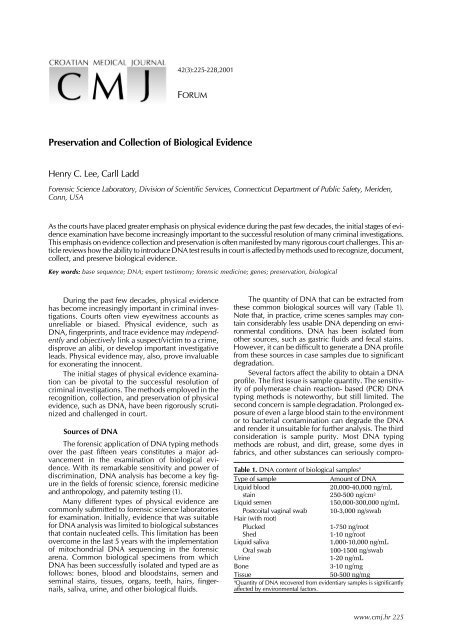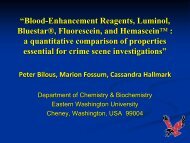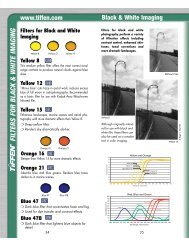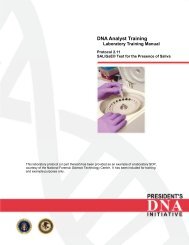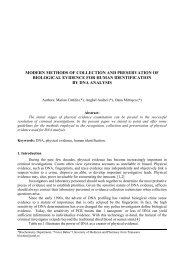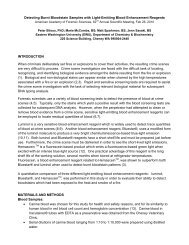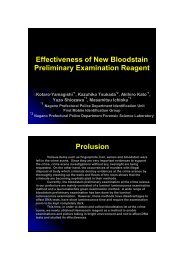Preservation and Collection of Biological Evidence
Preservation and Collection of Biological Evidence
Preservation and Collection of Biological Evidence
You also want an ePaper? Increase the reach of your titles
YUMPU automatically turns print PDFs into web optimized ePapers that Google loves.
42(3):225-228,2001<br />
FORUM<br />
<strong>Preservation</strong> <strong>and</strong> <strong>Collection</strong> <strong>of</strong> <strong>Biological</strong> <strong>Evidence</strong><br />
Henry C. Lee, Carll Ladd<br />
Forensic Science Laboratory, Division <strong>of</strong> Scientific Services, Connecticut Department <strong>of</strong> Public Safety, Meriden,<br />
Conn, USA<br />
As the courts have placed greater emphasis on physical evidence during the past few decades, the initial stages <strong>of</strong> evidence<br />
examination have become increasingly important to the successful resolution <strong>of</strong> many criminal investigations.<br />
This emphasis on evidence collection <strong>and</strong> preservation is <strong>of</strong>ten manifested by many rigorous court challenges. This article<br />
reviews how the ability to introduce DNA test results in court is affected by methods used to recognize, document,<br />
collect, <strong>and</strong> preserve biological evidence.<br />
Key words: base sequence; DNA; expert testimony; forensic medicine; genes; preservation, biological<br />
During the past few decades, physical evidence<br />
has become increasingly important in criminal investigations.<br />
Courts <strong>of</strong>ten view eyewitness accounts as<br />
unreliable or biased. Physical evidence, such as<br />
DNA, fingerprints, <strong>and</strong> trace evidence may independently<br />
<strong>and</strong> objectively link a suspect/victim to a crime,<br />
disprove an alibi, or develop important investigative<br />
leads. Physical evidence may, also, prove invaluable<br />
for exonerating the innocent.<br />
The initial stages <strong>of</strong> physical evidence examination<br />
can be pivotal to the successful resolution <strong>of</strong><br />
criminal investigations. The methods employed in the<br />
recognition, collection, <strong>and</strong> preservation <strong>of</strong> physical<br />
evidence, such as DNA, have been rigorously scrutinized<br />
<strong>and</strong> challenged in court.<br />
Sources <strong>of</strong> DNA<br />
The forensic application <strong>of</strong> DNA typing methods<br />
over the past fifteen years constitutes a major advancement<br />
in the examination <strong>of</strong> biological evidence.<br />
With its remarkable sensitivity <strong>and</strong> power <strong>of</strong><br />
discrimination, DNA analysis has become a key figure<br />
in the fields <strong>of</strong> forensic science, forensic medicine<br />
<strong>and</strong> anthropology, <strong>and</strong> paternity testing (1).<br />
Many different types <strong>of</strong> physical evidence are<br />
commonly submitted to forensic science laboratories<br />
for examination. Initially, evidence that was suitable<br />
for DNA analysis was limited to biological substances<br />
that contain nucleated cells. This limitation has been<br />
overcome in the last 5 years with the implementation<br />
<strong>of</strong> mitochondrial DNA sequencing in the forensic<br />
arena. Common biological specimens from which<br />
DNA has been successfully isolated <strong>and</strong> typed are as<br />
follows: bones, blood <strong>and</strong> bloodstains, semen <strong>and</strong><br />
seminal stains, tissues, organs, teeth, hairs, fingernails,<br />
saliva, urine, <strong>and</strong> other biological fluids.<br />
Table 1. DNA content <strong>of</strong> biological samples a<br />
Type <strong>of</strong> sample<br />
Amount <strong>of</strong> DNA<br />
Liquid blood<br />
20,000-40,000 ng/mL<br />
stain 250-500 ng/cm 2<br />
Liquid semen<br />
150,000-300,000 ng/mL<br />
Postcoital vaginal swab 10-3,000 ng/swab<br />
Hair (with root)<br />
Plucked<br />
1-750 ng/root<br />
Shed<br />
1-10 ng/root<br />
Liquid saliva<br />
1,000-10,000 ng/mL<br />
Oral swab<br />
100-1500 ng/swab<br />
Urine<br />
1-20 ng/mL<br />
Bone<br />
3-10 ng/mg<br />
Tissue<br />
50-500 ng/mg<br />
a<br />
Quantity <strong>of</strong> DNA recovered from evidentiary samples is significantly<br />
affected by environmental factors.<br />
The quantity <strong>of</strong> DNA that can be extracted from<br />
these common biological sources will vary (Table 1).<br />
Note that, in practice, crime scenes samples may contain<br />
considerably less usable DNA depending on environmental<br />
conditions. DNA has been isolated from<br />
other sources, such as gastric fluids <strong>and</strong> fecal stains.<br />
However, it can be difficult to generate a DNA pr<strong>of</strong>ile<br />
from these sources in case samples due to significant<br />
degradation.<br />
Several factors affect the ability to obtain a DNA<br />
pr<strong>of</strong>ile. The first issue is sample quantity. The sensitivity<br />
<strong>of</strong> polymerase chain reaction- based (PCR) DNA<br />
typing methods is noteworthy, but still limited. The<br />
second concern is sample degradation. Prolonged exposure<br />
<strong>of</strong> even a large blood stain to the environment<br />
or to bacterial contamination can degrade the DNA<br />
<strong>and</strong> render it unsuitable for further analysis. The third<br />
consideration is sample purity. Most DNA typing<br />
methods are robust, <strong>and</strong> dirt, grease, some dyes in<br />
fabrics, <strong>and</strong> other substances can seriously comprowww.cmj.hr<br />
225
Lee <strong>and</strong> Ladd: <strong>Evidence</strong> <strong>Collection</strong> <strong>and</strong> <strong>Preservation</strong> Croat Med J 2001;42:225-228<br />
mise the DNA typing process. Environmental insults<br />
will not change DNA allele “A” into allele “B”, but<br />
they can adversely affect the ability <strong>of</strong> the scientist to<br />
obtain a complete DNA pr<strong>of</strong>ile from the sample(2-4).<br />
<strong>Evidence</strong> Transfer<br />
DNA evidence can be used to make linkages or<br />
associations (e.g. person-person, person-other physical<br />
evidence, or person-crime scene). In general, biological<br />
evidence can be transferred by direct deposit or<br />
by secondary transfer.<br />
Direct Deposit<br />
Any biological evidence (blood, semen, body tissue,<br />
bone, hair, urine, <strong>and</strong> saliva) can be transferred<br />
to an individual’s body/clothing, object, or crime<br />
scene by direct deposit. Once biological fluids are deposited,<br />
they adhere to the surface <strong>and</strong> become<br />
stains. Non-fluid biological evidence, such as tissue<br />
or hair, can also be transferred by direct contact.<br />
Secondary Transfer<br />
Blood, semen, tissue, hair, saliva, or urine can be<br />
transferred to a person, object, or location through an<br />
intermediary (person or an object). With secondary<br />
transfer, there is no direct contact between the original<br />
source (donor <strong>of</strong> the biological evidence) <strong>and</strong> the<br />
target surface. Secondary transfer may, but does not<br />
necessarily, establish a direct link between an individual<br />
<strong>and</strong> a crime. The impact <strong>of</strong> secondary transfer<br />
on the interpretation <strong>of</strong> DNA results has been debated<br />
(5,6). However, secondary transfer is clearly a more<br />
significant concern with the more sensitive DNA typing<br />
methods, such as mitochondrial DNA sequencing<br />
<strong>and</strong> low copy number PCR.<br />
<strong>Evidence</strong> Recognition<br />
The first step in a criminal investigation is determining<br />
which samples warrant further testing. This<br />
phase is crucial to the outcome <strong>of</strong> the investigation<br />
<strong>and</strong> very challenging, as crime scenes can be both<br />
complex <strong>and</strong> chaotic. Hence, an experienced investigator<br />
who systematically evaluates the scene is an invaluable<br />
resource. Recognition is the ability to identify<br />
probative evidence (at the scene or in the laboratory)<br />
scattered among potentially vast quantities <strong>of</strong> redundant,<br />
irrelevant, or unrelated items. For instance,<br />
collecting 20 bloodstains from the vicinity <strong>of</strong> a stabbing<br />
victim may not point to the perpetrator. The recognition<br />
process involves basic forensic principles,<br />
such as pattern recognition <strong>and</strong> analysis <strong>and</strong> physical<br />
properties observation. Naturally, if crucial evidence<br />
is not recognized, collected, <strong>and</strong> preserved, its value<br />
to the trier <strong>of</strong> fact will be lost.<br />
Documentation <strong>of</strong> DNA <strong>Evidence</strong><br />
The location <strong>and</strong> condition <strong>of</strong> any biological evidence<br />
must be thoroughly documented before its collection.<br />
Careful evidence documentation at the crime<br />
scene, autopsy room, <strong>and</strong> forensic laboratory is essential.<br />
In any criminal or civil investigation, documentation<br />
has great bearing on whether the evidence<br />
can later be introduced in court. <strong>Evidence</strong> should not<br />
be processed or moved until its original condition<br />
<strong>and</strong> other relevant information have been recorded.<br />
Several different means <strong>of</strong> documentation are available.<br />
Generally, the use <strong>of</strong> more than one method is<br />
advised. The basic approach <strong>of</strong> evidence documentation<br />
<strong>and</strong> h<strong>and</strong>ling is outlined in Tables 2 <strong>and</strong> 3.<br />
<strong>Collection</strong> <strong>and</strong> <strong>Preservation</strong> <strong>of</strong> <strong>Biological</strong><br />
<strong>Evidence</strong><br />
The ability to introduce DNA findings in court is<br />
also greatly impacted by evidence collection <strong>and</strong><br />
preservation methods. <strong>Evidence</strong> integrity, both scientific<br />
<strong>and</strong> legal, begins with the first investigator at the<br />
crime scene. Detailed evidence collection protocols<br />
have been previously described (7-13). The specific<br />
collection method employed will depend on the state<br />
<strong>and</strong> condition <strong>of</strong> the biological evidence. In general,<br />
a significant quantity <strong>of</strong> material should be collected<br />
to ensure the recovery <strong>of</strong> sufficient DNA for testing<br />
purposes. However, it is important to limit collecting<br />
additional dirt, grease, fluids, <strong>and</strong> other material from<br />
the surrounding area, since many substances are<br />
known to adversely affect the DNA typing process.<br />
Each biological specimen should be packaged according<br />
to established forensic practices. Once the<br />
samples have been collected, they should be<br />
promptly delivered to the forensic laboratory. To minimize<br />
specimen deterioration, items should be stored<br />
in a cool, dry environment until they are submitted<br />
for testing.<br />
Many famous investigations, such as O.J.<br />
Simpson <strong>and</strong> J.B. Ramsey, highlight the importance <strong>of</strong><br />
effective crime scene processing (13,14). In the legal<br />
arena, unless the evidence is properly documented,<br />
collected, packaged, <strong>and</strong> preserved, it may not meet<br />
the legal <strong>and</strong> scientific requirements for admissibility<br />
into a court <strong>of</strong> law. If the DNA evidence is not properly<br />
documented before the collection, its origin can<br />
be questioned. If it is improperly collected or packaged,<br />
the possibility <strong>of</strong> contamination will be raised<br />
to discredit the DNA results. Given the prospect <strong>of</strong> legal<br />
challenges <strong>and</strong> the sensitivity <strong>of</strong> PCR methods, it<br />
is essential that strict contamination prevention measures<br />
be followed.<br />
Legal concerns <strong>of</strong>ten diverge from empirical<br />
data. Even though PCR-based typing methods are sensitive,<br />
the contamination argument has been exaggerated<br />
in some cases (5,15). Moreover, it is important to<br />
note that, since all multi-locus DNA pr<strong>of</strong>iles (ie, >6<br />
STR loci typed) are rare, contamination will predominantly<br />
lead to false exclusions or artificial mixtures<br />
rather than false inclusions. Consequently, albeit contamination<br />
could complicate result interpretation, it<br />
would typically not include the defendant.<br />
Challenges to DNA Admissibility<br />
Since their introduction into forensic science,<br />
DNA typing methods have been strenuously attacked<br />
in court (Table 4). Initially, the reliability <strong>of</strong> DNA typing<br />
procedures was questioned along with the statistical<br />
methods used to calculate DNA pr<strong>of</strong>ile frequencies.<br />
In the last few years, legal challenges regarding<br />
the admissibility <strong>of</strong> DNA have shifted their focus<br />
226
Lee <strong>and</strong> Ladd: <strong>Evidence</strong> <strong>Collection</strong> <strong>and</strong> <strong>Preservation</strong> Croat Med J 2001;42:225-228<br />
away from the general reliability <strong>of</strong> the methods. Although<br />
most courts are comfortable with DNA testing<br />
in principle, some defense objections regarding DNA<br />
evidence continue to be effective. Successful challenges<br />
to the admissibility <strong>of</strong> DNA testing <strong>of</strong>ten address<br />
the initial collection, preservation, <strong>and</strong> subsequent<br />
h<strong>and</strong>ling <strong>of</strong> the biological evidence. The specter<br />
<strong>of</strong> evidence tampering may also be raised. Another<br />
common case-specific challenge concedes that<br />
DNA typing methods are reliable in theory. Here, the<br />
defense may suggest that critical mistakes were made<br />
in testing (sample switches, contamination, devia-<br />
Table 2. <strong>Evidence</strong> documentation <strong>and</strong> collection<br />
A. <strong>Evidence</strong> at a crime scene<br />
Photograph the evidence before it is touched, moved, or collected.<br />
Videotape the evidence <strong>and</strong> its relative position at the crime scene.<br />
Document the location <strong>and</strong> condition <strong>of</strong> the evidence.<br />
Note <strong>and</strong> sketch the spatial relationship <strong>of</strong> the evidence relative to other objects at the scene.<br />
Label, initial, <strong>and</strong> seal the evidence package.<br />
B. <strong>Evidence</strong> at the forensic laboratory<br />
Note the package, label, <strong>and</strong> seal condition <strong>of</strong> the item.<br />
Label the package with initials, unique case identifier, <strong>and</strong> date.<br />
Check the item number <strong>and</strong> compare it to the submission form to ensure that the correct item has been received. Also verify that<br />
the description <strong>of</strong> the item is accurate.<br />
Note, sketch, <strong>and</strong>/or photograph the contents <strong>of</strong> the package.<br />
Document the location <strong>and</strong> condition <strong>of</strong> biological evidence on the item prior to any sampling. Note when secondary cuttings <strong>of</strong><br />
the evidence are taken; include the area where the cutting was collected. Package any sub-items separately.<br />
When testing is conducted, record quantity <strong>of</strong> sample consumed, the test performed, <strong>and</strong> the results obtained. When h<strong>and</strong>ling the<br />
evidence, always wear clean, disposable gloves to minimize contamination.<br />
C. <strong>Evidence</strong> at the autopsy room<br />
Photograph the body <strong>and</strong> any additional evidence before cleaning the body.<br />
Note <strong>and</strong> sketch the evidence.<br />
Systematically collect each piece <strong>of</strong> evidence with clean tools.<br />
Separately package each item in a proper container.<br />
Label the container <strong>and</strong> note the quantity <strong>of</strong> sample collected. Do not add preservatives, such as formaldehyde to the specimen.<br />
Store the item appropriately.<br />
Carefully collect the clothing to avoid losing trace evidence <strong>and</strong> to avoid contamination with other biological samples.<br />
Release the evidence according to proper procedures.<br />
Table 3. Laboratory processing <strong>of</strong> DNA evidence<br />
A. Laboratory receipt <strong>of</strong> evidence<br />
Physical evidence should be submitted to the laboratory with a transmittal letter, inventory sheet, <strong>and</strong> notation <strong>of</strong> the type <strong>of</strong><br />
examination requested for each item according to st<strong>and</strong>ard laboratory protocols.<br />
All identifying information on the physical evidence should be checked against the submission forms. Any discrepancies should be<br />
noted <strong>and</strong> corrected.<br />
Each package should be properly packaged, sealed, <strong>and</strong> labeled. Any sign <strong>of</strong> improper packaging, sealing, or labeling should be<br />
noted.<br />
Note any sign <strong>of</strong> sample leakage or contamination.<br />
Any special requests/instructions regarding the DNA testing should be recorded on the submission form.<br />
A receipt for evidence showing the date, time, submitting agency, submitter’s name, case number, item numbers, <strong>and</strong> the<br />
receiver’s name should be issued.<br />
Physical evidence submitted for DNA analysis should be transmitted as soon as possible to the DNA unit <strong>and</strong> stored appropriately.<br />
B. Laboratory initial processing procedures<br />
An evidence examination form should be used to record the preliminary processing <strong>of</strong> each item. It should contain the following<br />
data:<br />
a) Package description <strong>and</strong> actual contents;<br />
b) Label information, local case number;<br />
c) Description/condition <strong>of</strong> evidence;<br />
d) Laboratory case <strong>and</strong> item number;<br />
e) Date <strong>and</strong> initials <strong>of</strong> examiner.<br />
Document the size, location, pattern, <strong>and</strong> condition <strong>of</strong> the stained area.<br />
Weigh biological evidence, such as bone, teeth, nail, <strong>and</strong> tissue as necessary. Note the quantity used for DNA analysis.<br />
Record any preliminary test results <strong>and</strong> any trace evidence recovered.<br />
Record information about each sample subjected to DNA analysis, as follows:<br />
Case number, item number, <strong>and</strong> description; examiners’ initials;<br />
Reagent lot number; protocol followed; quantity <strong>of</strong> sample consumed.<br />
Testing results on each item should be entered on the appropriate worksheets.<br />
H<strong>and</strong>le samples carefully to avoid mislabeling or cross contamination.<br />
Whenever feasible, a portion <strong>of</strong> the sample should be preserved for possible future analysis. These specimens should be stored in a<br />
freezer. However, in many instances the item cannot be divided due to insufficient quantity. In this event, the sample should be<br />
processed according to st<strong>and</strong>ard forensic laboratory guidelines.<br />
Any secondary cutting for DNA analysis should be placed in a separate container, package, or tube (labeled accordingly).<br />
Unused DNA should be properly labeled <strong>and</strong> stored in a freezer.<br />
227
Lee <strong>and</strong> Ladd: <strong>Evidence</strong> <strong>Collection</strong> <strong>and</strong> <strong>Preservation</strong> Croat Med J 2001;42:225-228<br />
tions from laboratory protocols, misinterpretation <strong>of</strong><br />
results, etc), which should invalidate the findings.<br />
With this strategy, typically the technical expertise <strong>of</strong><br />
a particular laboratory or analyst is criticized.<br />
Table 4. DNA admissibility challenges<br />
1. Genetics issues<br />
2. Procedural/technical issues<br />
3. Results interpretation<br />
4. Statistics<br />
5. Contamination/other case-specific issues<br />
Conclusion<br />
The application <strong>of</strong> DNA technology in criminal<br />
investigations has grown rapidly in the past 15 years.<br />
DNA analysis has proven an extremely powerful<br />
weapon for both prosecution <strong>and</strong> defense. Throughout<br />
the world, DNA evidence has provided the critical<br />
linkages leading to numerous convictions. DNA’s<br />
power as an exclusionary tool is equally noteworthy.<br />
However, DNA evidence that is not properly recognized,<br />
documented, collected, <strong>and</strong> preserved may ultimately<br />
be <strong>of</strong> no value to a criminal investigation. A<br />
greater appreciation <strong>of</strong> the importance <strong>of</strong> evidence<br />
collection <strong>and</strong> preservation is warranted or the forensic<br />
community may not be able to use this tool in the<br />
interest <strong>of</strong> justice.<br />
References<br />
1 Lee HC, Ladd C, Bourke MT, Pagliaro E, Tirnady F.<br />
DNA typing in forensic science. Am J Forensic Med<br />
Pathol 1994;15:269-82.<br />
2 Bourke MT, Scherczinger CA, Ladd C, Lee HC. NaOH<br />
Treatment to neutralize inhibitors <strong>of</strong> Taq polymerase. J<br />
Forensic Sci 1999;44:1046-50.<br />
3 Adams DE, Presley LA, Baumstark AL, Hensley KW,<br />
Hill AL, Anoe KS, et al. DNA analysis by restriction fragment<br />
length polymorphisms <strong>of</strong> blood <strong>and</strong> other body<br />
fluid stains subjected to contamination <strong>and</strong> environmental<br />
insults. J Forensic Sci 1991;36:1284-98.<br />
4 van Oorschot RA, Gutowski SJ, Robinson SL, Hedley<br />
JA, Andrews IR. HUMTHO1 validation studies: effects<br />
<strong>of</strong> substrate, environment, <strong>and</strong> mixtures. J Forensic Sci<br />
1996;41:142-5.<br />
5 Ladd C, Adamowicz MS, Bourke MT, Scherczinger CA,<br />
<strong>and</strong> Lee HC. A systematic analysis <strong>of</strong> secondary transfer.<br />
J Forensic Sci 1999;44:1270-2.<br />
6 van Oorschot RA, Jones MK. DNA fingerprints from fingerprints.<br />
Nature 1997;387:767.<br />
7 Lee HC, Gaensslen RE, Bigbee PD, Kearney JJ. Guidelines<br />
for the collection <strong>and</strong> preservation <strong>of</strong> DNA evidence.<br />
Washington (DC): US Department <strong>of</strong> Justice,<br />
Federal Bureau <strong>of</strong> Investigation; 1990.<br />
8 Lee HC, Gaensslen RE, Bigbee MS, Kearney JJ. Guidelines<br />
for the collection <strong>and</strong> preservation <strong>of</strong> DNA evidence.<br />
Journal <strong>of</strong> Forensic Idententification<br />
1991;41:344-56.<br />
9 Lee HC, Gaensslen RE, Pagliaro EM, Mills RJ, Zercie<br />
KB. Physical evidence in criminal investigation. Westbrook<br />
(CT): Narcotic Enforcement Officers Association;<br />
1991.<br />
10 Lee HC, editor. Crime scene investigation. Taoyuan<br />
(Taiwan): Central Police University Press; 1994.<br />
11 Lee HC, editor. Physical evidence. Enfield (CT):<br />
Magnani <strong>and</strong> McCormic; 1995.<br />
12 Lee HC, Ladd C, Scherczinger CA, Bourke MT. Forensic<br />
applications <strong>of</strong> DNA typing: collection <strong>and</strong> preservation<br />
<strong>of</strong> DNA evidence. Am J Forensic Med Pathol<br />
1998;19:10-8.<br />
13 Lee HC, Palmbach T, Miller M. Henry Lee’s crime<br />
scene h<strong>and</strong>book. New York (NY): Academic Press. In<br />
press 2001.<br />
14 Lee HC, Labriola J. Famous crimes revisited. Southington<br />
(CT): Strong Books; 2001.<br />
15 Scherczinger CA, Ladd C, Bourke MT, Lee HC. A systematic<br />
approach to PCR contamination. J Forensic Sci<br />
1999;44:1042-5.<br />
Received: March 29, 2001<br />
Accepted: April 20, 2001<br />
Correspondence to:<br />
Henry C. Lee<br />
CT Forensic Laboratory<br />
278 Colony Street<br />
Meriden, CT 06451, USA<br />
joseph.sudol@po.state.ct.us<br />
228


